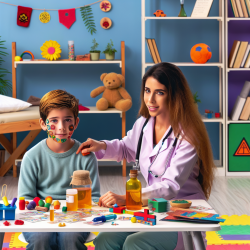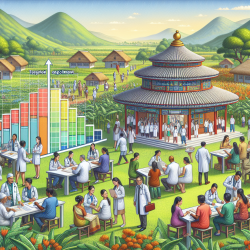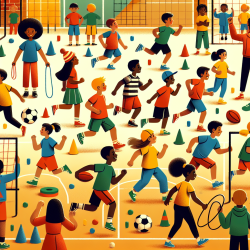Enhancing Pediatric Therapy: Insights from the World Congress Integrative Medicine & Health 2017

The field of pediatric therapy is constantly evolving, and staying informed about the latest research is crucial for practitioners aiming to improve their skills and create better outcomes for children. The World Congress Integrative Medicine & Health 2017 presented several key findings that can significantly impact pediatric therapy. This blog will explore some of these findings and discuss how practitioners can implement these insights to enhance their practice.
Understanding the Research
The World Congress Integrative Medicine & Health 2017 featured numerous studies, but one particularly relevant to pediatric therapy is the investigation into complementary and integrative medicine (CIM) in nursing homes. The study, titled "Complementary and Integrative Medicine in Nursing Homes – Effects on Caregivers in a Prospective, Exploratory, Comparative, Two-Armed Cohort Study," offers valuable insights into how integrative approaches can benefit caregivers, which can be extrapolated to pediatric settings.
Key Findings
The study compared nursing homes utilizing Kneipp Therapy (KT), a form of CIM that includes hydrotherapy, herbal medicine, mind-body medicine, physical activities, and healthy nutrition, with those using routine health preventive interventions. Key outcomes for caregivers included:
- Improved job satisfaction and reduced burnout (p < 0.001 and p = 0.008, respectively).
- Better feedback mechanisms (p = 0.043).
- Increased sense of community and physical health after 12 months (p = 0.047 and p = 0.039, respectively).
Although this study focused on caregivers, the positive impacts on job satisfaction and burnout are indicative of the potential benefits that similar integrative approaches could have in pediatric therapy settings. Happy, healthy caregivers and therapists are better equipped to provide high-quality care, which directly benefits children.
Implementing Integrative Approaches in Pediatric Therapy
Based on these findings, pediatric therapists can consider integrating similar CIM practices into their therapy sessions. Here are a few practical steps:
- Incorporate Mind-Body Techniques: Techniques such as mindfulness, yoga, and relaxation exercises can help both therapists and children manage stress and improve overall well-being.
- Use of Herbal Medicine: Under proper guidance and with consideration of any contraindications, certain herbal remedies can be integrated to support physical health and manage symptoms.
- Promote Physical Activities: Encouraging regular physical activity tailored to each child's abilities can enhance physical health and mental well-being.
- Focus on Nutrition: Educating families about healthy nutrition and its impact on therapy outcomes can be a powerful tool for improving children's health.
Encouraging Further Research
While the study provides a strong foundation, more research is needed to fully understand the benefits of CIM in pediatric therapy. Practitioners are encouraged to participate in or conduct further studies to explore the efficacy of these integrative approaches in various pediatric populations. Collaboration with research institutions and staying updated with the latest findings will ensure that therapy practices remain evidence-based and effective.
Conclusion
Integrating complementary and integrative medicine into pediatric therapy can offer numerous benefits, including improved job satisfaction for therapists and better outcomes for children. By incorporating mind-body techniques, herbal medicine, physical activities, and nutritional guidance, therapists can enhance their practice and contribute to the well-being of their young clients. Continued research and collaboration will be key to further understanding and optimizing these integrative approaches.
To read the original research paper, please follow this link: World Congress Integrative Medicine & Health 2017: part three
Citation: Ortiz, M., Schnabel, K., Teut, M., Rotter, G., Binting, S., Cree, M., Lotz, F., Suhr, R., Brinkhaus, B., Parvizi, M. M., Handjani, F., Zarshenas, M. M., Moein, M. R., Nimrouzi, M., Hatam, G., Hasanzadeh, J., Hamidizadeh, N., Heydari, M., Namazi, M. R., Pasalar, M., Mosaffa-Jahromi, M., Bagheri-Lankarani, K., Afsharypuor, S., Tamaddon, A. M., Ostovar, M., Peloni, G., Bolliger, I., Faria, R. M. D. C., Quadri, P., Sanzeni, W., Zemp, D., Risvoll, H., Giverhaug, T., Halvorsen, K. H., Waaseth, M., Musial, F., Rossi, E., Baccetti, S., Picchi, M., Conti, T., Firenzuoli, F., Guido, C., Bosco, F., Panozzo, M., Cervino, C., Nurra, L., Traversi, A., Vuono, K., Sabatini, F., Bellandi, T., Rutert, B., Eggert, A., Seifert, G., Stritter, W., Holmberg, C., Längler, A., Salamonsen, A., Wiesener, S., Schad, F., Steele, M., Kröz, M., Matthes, H., Herbstreit, C., Thronicke, A., Schlingensiepen, I., von Schoen-Angerer, T., Schneider, R., Waeber, L., Vagedes, J., Kaczala, G., Pharisa, C., Wildhaber, J., Huber, B., Sidorov, P., Sovershaeva, E., Simões-Wüst, A. P., Nietlispach, A., Mennet, M., Schnelle, M., von Mandach, U., Wang, X., Woo, H. L., Lee, J. M., Wu, Y., Cho, Y., Yun, Y., Kim, H., Jung, W., Jang, B.-H., Ziea, E., Hui, H., Li, M., Tsui, D., Lam, C., Hsieh, J., Chan, E., Balneaves, L., Burnside, S., Doyle, E., Dorazio, S., Chan, P. K., Bhagra, A., Chen, P.-H., Chung, V. C. H., Wu, J. C. Y., Lin, Z. X., Wong, W., Wu, X. Y., Ho, R. S. T., Wong, C. H. L., Elder, W., Cardarelli, R., Kaspar, C., Kempenich, R., Kopferschmitt, J., Marinko, Z., Sebo, D., Vcev, A., Monezi, R., Ruggerini, E. M., Fuchigami, I. M., Mazini, A. C. M., Oliveira, M. W., Papuga, P., Schloss, J., Steel, A., Jacobsen, M. D. S., Jacobsen, M. R., Mangini, M. T., Trapani, G., Di Giampietro, T., Zanino, L., Ciullo, L., Lanaro, D., Cerritelli, F., Macrì, F., Tsai, A., Lin, C., Wu, T.-H., D’Alessandro, E., Watts, S., Zhang, Y., Wu, X., Li, X., Fei, Y., Liu, J., Zhao, N., Jia, L., Yan, X., Zhou, L., Meng, Z., Li, W., Daneshfard, B., Hosseinkhani, A., Tafazoli, V., Jaladat, A. M., Sadeghi, H., Jia, L., Zhao, N., Yan, X., Zhou, L., Meng, Z., Li, W., Liu, J., Larsen, A. L., Salamonsen, A., Kristoffersen, A. E., Hamran, T., Evjen, B., Stub, T., Li, M., Cai, J., Lu, T., Yin, L., Wu, D., Wang, L., Liew, S. M., Liu, T., Bai, C., Zheng, Z., Wan, Y., Xu, J., Wang, X., Yu, H., Gu, X., Liu, Z., Yan, X., Jia, L., Zhao, N., Yang, G., Liu, J., Mozaffarpour, S., Behmanesh, E., Nimrouzi, M., Tafazoli, V., Daneshfard, B., Pasalar, M., Tabatabei, F., Amini, F., Sathasivampillai, S., Rajamanoharan, P., Munday, M., Heinrich, M., Scherrer, Y. M., Heinrich, M., Szuter, C., Amini, F., Tavakoli, A., Tavakoli, F., Pasalar, M., Rostami, M., Torri, M. C., Szuter, C., Hanser, S., Heckel, V., Krüerke, D., Simões-Wüst, A. P., Weiss, S., Metzner, S., Lee, J. W., Hyun, M. K., Masetti, M., Oepen, R., Gruber, H., Heusser, P., Pelz, H., Perlitz, V., Ponstein, A., Abbing, A., Baars, E., Robinson, N., Ronan, P., Mian, A., Madge, S., Lorenc, A., Agent, P., Carr, S., Winnubst, M. E., Monezi, R., Abolghasemi, J., Heydari, M., Baccetti, S., Rossi, E., Fedi, P., Di Stefano, M., Belvedere, K., Beaven, K., Rose, A., Florschutz, G., Brough, N., Parsons, H., Stewart-Brown, S., McEwen, B., Melo, F., Fontana, F. M., Valle, A. C. V., Neres, M. T. B., Mohagheghzadeh, A., Zohalinezhad, M. E., Njaradi, O., Dunjic, M., Ostrowski, D., Fox, K., Pokladnikova, J., Selke-Krulichova, I., Seo, J., Jang, H., Simões-Wüst, A. P., Moltó-Puigmartí, C., van Dongen, M., Dagnelie, P., Thijs, C., Tihanyi, E., Hegyi, G., Zhang, Y., Li, X., Fei, Y., Liu, J., Zhang, Y., Liu, J., Tong, X. (2017). World Congress Integrative Medicine & Health 2017: part three. BMC Complementary and Alternative Medicine, 17(Suppl 1). https://doi.org/10.1186/s12906-017-1784-2










